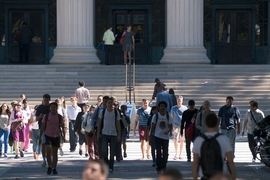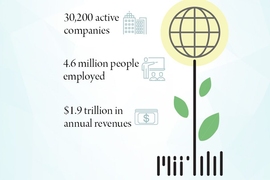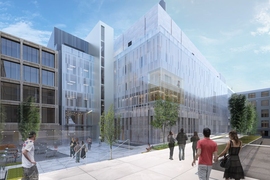Below is the text of a letter sent Friday by MIT President L. Rafael Reif to the chairmen of three congressional committees in response to a request of the 56 U.S. colleges and universities with endowments of more than $1 billion. (Read the full explanation of MIT's endowment here.)
Dear Chairman Hatch, Chairman Brady and Chairman Roskam,
On behalf of the Massachusetts Institute of Technology (MIT), thank you for your letter on university endowments, dated February 8, 2016. We are grateful for the opportunity to participate in this discussion and pleased to clarify the role of our endowment.
The following pages offer detailed answers to your questions about our endowment’s value, management and use. These financial facts only begin to express what our endowment is worth, however, because in a real sense, the value of our endowment is the value of everything the people of MIT accomplish. At MIT, our mission charges us to advance knowledge, to educate students and to bring knowledge to bear on great challenges, for the betterment of humankind. As we strive to serve the nation and the world, our endowment is crucial fuel.
As we describe in detail, our endowment is not a single account of ready cash. Instead, it consists of thousands of individual funds, usually subject to multiple restrictions from their donors. With very rare exceptions, these restrictions require that MIT hold a gift’s principal forever. In many instances, donors also restrict the income on these gifts to supporting a specific purpose, such as scholarships for students or faculty salaries. A smaller fraction of the endowment consists of funds that allow greater flexibility for us to use in a manner consistent with the Institute’s mission. In combination, such endowed funds from donors, and funds MIT endows itself — which comprise a much smaller portion of the endowment — give the Institute the stability to sustain our core commitments and the nimbleness to seize new opportunities.
To illustrate, I offer four examples of how MIT’s endowment makes it possible for us to pursue goals central to the national interest:
- Increasing the affordability of an MIT education,
- Inventing new, low-cost pathways to make higher education accessible to all,
- Pioneering vital areas of research, and
- Supporting innovation as an economic engine for our region and the nation.
Your endowment research has emerged in the context of national concern about the cost of higher education and the burdens of student debt. At MIT, we use the power of our endowment to address these deep systemic problems in two ways: through an aggressive program of financial support for our own students, and by leading a revolution in open digital learning that promises to make higher education radically more accessible to all.
Increasing the Affordability of an MIT Education
As an institution built on meritocracy, MIT is committed to admitting undergraduate applicants without considering their ability to pay. Hand in hand with this need-blind admissions policy, we work closely with families who qualify for financial aid to tailor a plan to suit their unique circumstances, so that no student admitted to MIT is held back by the cost.
The cost to MIT of educating an undergraduate student for a year has risen to about twice what we charge in annual tuition. Providing the advanced technological education MIT is known for depends on attracting and retaining the best faculty, building and maintaining premier educational and research facilities, and supporting student engagement in research, pushing the “sticker price” of a college education higher. However, we have made sure that the funds available for student aid have grown even faster. For instance, last month, we announced the Institute’s 2016-17 tuition and financial aid rates. While tuition and fees will increase by 3.7%, the budget for undergraduate financial aid will grow at nearly three times that rate, by 10.4%. In total, we intend to spend $114.2 million next year to help undergraduates cover the cost of attending MIT. To give a sense of the trend that is nearly quadruple the $30.5 million we spent on undergraduate aid in 2000.
Cumulatively, these efforts mean that more MIT students are getting more aid and graduating with less debt. In 2014-15, 60% of MIT undergraduates received need-based financial aid. For MIT students receiving such aid, the average financial aid award from all sources was $43,298, or about 96% of tuition. And 33% of students on aid received sufficient scholarship funding to pay no tuition at all.
Two decades ago, only 35% of seniors graduated from MIT debt free. Last year, 68% graduated with no debt. On average, 56% of families receiving a 2014-15 MIT scholarship benefited from having their actual net price reduced to $16,556. For comparison, that is less than the average full “in-state” cost of attending a public four-year institution, which in the same year was about $23,410 before financial aid.
Growth in our endowment also makes it possible for MIT to extend the impact of resources the federal government makes available to our students. Students receiving both Pell Grants and need-based financial aid from MIT benefit from MIT’s Pell Grant Matching Program, which helps students to graduate with little or no debt. MIT established that program in 2006 to allow our students to use their Pell Grants to defray what we expect them to contribute to their education through work and loans.
This level of support is a direct product of the growth of MIT endowment funds committed to financial aid.
For a full description of MIT’s story of affordability for undergraduate students, please visit http://affordable.mit.edu.
Inventing New, Low-cost Pathways to Make Higher Education Accessible to All
While we count on our endowment to provide financial aid for talented students of limited means, the physical limits of our campus and our faculty’s size sharply constrain the number of students we can teach in person. Each year, with regret, we are forced to turn away thousands of applicants who could benefit from an MIT educational experience — and we know there are many thousands more across the country and around the world.
Over the past 15 years, MIT has addressed this inequity by pioneering the use of digital technologies to make high-quality educational content available to anyone who wants to learn:
- In 2001, MIT launched OpenCourseWare (OCW), a website that offers virtually all MIT course content, including videos, syllabi, simulations, lecture notes and exams, online and free of charge. To date, our faculty have posted materials from 2,260 courses and served more than 175 million learners.
- Building on the extraordinary demand revealed by OCW, in 2011 MIT announced the launch of MITx, an open source, not-for-profit digital educational tool for providing massive open online courses (MOOCs) to learners around the world, also free of charge. To date, we have used MITx to deliver MIT content to about 1.7 million unique learners — nearly 13 times the number of MIT’s living alumni.
- In May 2012, we collaborated with Harvard University to launch an online learning destination and MOOC provider called edX. As the only leading MOOC provider that is both nonprofit and open source, edX serves as a platform on which dozens of global universities host their MOOCs. To date, edX has delivered nearly 900 courses to seven million unique users, and counts among its partners more than 90 leading global universities, nonprofits and institutions — including Princeton University, the Smithsonian, Harvey Mudd College and Amnesty International.
- And last fall, we launched a pilot program in one of our professional master’s degree programs that allows learners worldwide to take a semester’s worth of courses entirely online, and then complete an MIT master’s degree by spending a single semester on campus. The combination of online courses and one residential semester opens the program to many more learners and creates a pathway to a master’s degree for relatively little cost.
Over the years, these efforts have relied on extensive foundation support — but the earliest phase of each of these ideas depended on endowment support.
Pioneering Vital Areas of Research
MIT is a community of hands-on problem solvers, grounded in the STEM fields, who seek rigorous answers to hard questions. Of the 3,439 degrees MIT awarded in 2014-15, two-thirds were in engineering or science disciplines. About 94% of our current undergraduates who have declared a major have done so in a science or engineering field. And about two-thirds of our 1,021 faculty hold appointments in the Schools of Science and Engineering. Funding from the endowment gives these problem solvers the flexibility they need to jumpstart ambitious new research before it might be considered “grant ready.” This jumpstart approach has helped us pursue new approaches in fields ranging from cancer, Alzheimer’s, autism and AIDS, to energy technology, advanced computing and engineering systems.
Through the endowment, we are able to build laboratories, purchase equipment and hire personnel to support research in areas that matter deeply to all of us. As one example, in June 2014, MIT began work on a major capital project to build a 200,000-square-foot center for nanoscience and nanotechnology at the heart of our campus. The project, called “MIT.nano,” will present new tools to nurture game-changing innovation in fields as diverse as health, energy, quantum science, manufacturing and computing. The promise of MIT.nano is profound. For instance, cloud computing already consumes 1.3% of the world’s electricity. As this technology expands, its energy use is projected to grow a thousandfold over the coming decade. Hardware based on nanoscale switching elements — a new technology now being pursued by MIT researchers — could prove crucial in helping the world meet its growing energy needs.
Working side by side with our faculty on research is also vital to our students’ educational experience. Nearly 50 years ago, MIT launched the Undergraduate Research Opportunities Program (UROP), a first-of-its-kind initiative that reimagined the role of research in our undergraduates’ education. Today, more than 80% of MIT’s undergraduate students participate in the program, working in faculty labs on frontline research. And for MIT’s graduate students — who comprise 60% of our student body — research is their education. Each year, more than 2,500 graduate students at MIT hold appointments as research assistants or research trainees. We rely on our endowment to give our faculty the freedom to pursue bold new lines of ideas and to enable our students to join them in racing to the frontier.
Our researchers — faculty, staff and students alike — want to make a positive impact on serious problems, and thanks to our endowment, they do.
Supporting Innovation as an Economic Engine for our Region and the Nation
I began by observing that the truest way to value our endowment is to weigh the accomplishments of the people of MIT. One inspiring measure of that value: a new report that concludes that, as of 2014, MIT’s living alumni launched more than 30,000 active companies, creating 4.6 million jobs and generating roughly $1.9 trillion in annual revenue. Taken together, this “MIT Nation” is equivalent to the 10th-largest economy in the world.
In addition to this broad economic impact, MIT is actively using the power of its real estate holdings to develop MIT’s home neighborhood, Cambridge’s Kendall Square, already a world capital of biotech innovation. Last fall, an article in WIRED magazine referred to a Kendall corner of our campus -- the intersection of Vassar Street and Main Street -- as perhaps “the most innovative and productive crossroads in history,” and suggested that “this one corner may generate one per cent to two per cent of the future global economy and may be a model for creating jobs, knowledge and power in other cities.”
Part of this story is MIT’s entrepreneurial culture: Kendall Square is already home to energy, biotech and digital start-ups, many direct spin-offs from MIT. The area has produced profound benefits to the nation. Another key element is our openness to collaboration with industry, an attitude that has brought to the region an extraordinary array of corporate research headquarters, including those of many of the largest pharmaceutical firms in the world. But going forward, our strategic development of the real estate holdings in our endowment will be crucial to realizing the full potential of Kendall to deliver growth to the national economy and meaningful solutions to the world.
Conclusion
MIT thrives in large part because our endowment provides a reliable way to attend to many of our core needs and the flexibility to reach for the future. Through careful stewardship, the endowment presents an enormous opportunity to extend MIT’s mission in ways that benefit the nation and the world.
Thank you for the work you are doing to advance this important national conversation. I hope you will let us know if you have further questions. We would welcome a visit to campus if you would be interested in taking a closer look at the work of MIT.
Sincerely,
L. Rafael Reif












